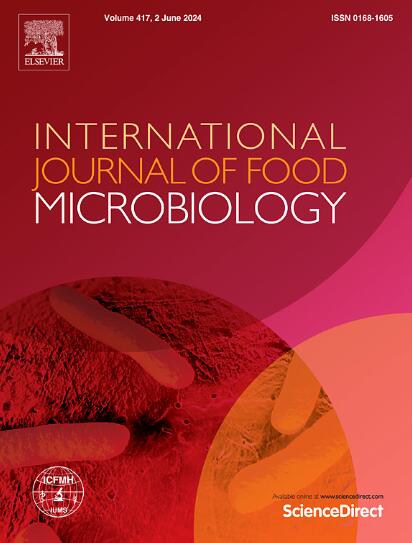Spoilage potential of Bacillus isolated from cooked sausage: Bidirectional verification from in vitro to in situ
IF 5
1区 农林科学
Q1 FOOD SCIENCE & TECHNOLOGY
International journal of food microbiology
Pub Date : 2025-02-20
DOI:10.1016/j.ijfoodmicro.2025.111114
引用次数: 0
Abstract
Understanding the role of common microorganisms in the spoilage of cooked sausages is essential for developing effective preservation strategies. In the framework of this study, six potential spoilage microorganisms were isolated from spoiled cooked sausages, identified through morphological, physiological, and genetic analyses as Bacillus cereus (two strains), Bacillus safensis, Bacillus altitudinis, Bacillus megaterium, and Bacillus infantis. All isolates exhibited significant protein or lipid degradation activities, except for B. infantis. The spoilage potential of Bacillus was systematically evaluated using a cooked sausage inoculation model in situ based on physical, chemical, and biological changes. Results indicated that Bacillus rapidly colonized cooked sausages, accelerating protein and lipid degradation and thereby deteriorating appearance and texture. Additionally, 74 volatile organic compounds (VOCs) were identified in both Bacillus-inoculated and control samples, revealing that Bacillus transformed aroma compounds such as terpenes into off-flavor compounds like alcohols, aldehydes, and acids (e.g., 1-octen-3-ol, nonanal, and phenylacetic acid). Correlation analysis confirmed the association of Bacillus with spoilage characteristics and VOCs evolution. This study elucidates the spoilage potential and mechanisms of Bacillus in cooked sausages, providing a foundation for developing an effective quality control strategy.

从熟香肠中分离的芽孢杆菌的腐败潜力:从体外到原位的双向验证
了解常见微生物在熟香肠变质中的作用对于制定有效的保存策略至关重要。在本研究的框架内,从变质的熟香肠中分离出6种潜在的腐败微生物,通过形态、生理和遗传分析鉴定为蜡样芽孢杆菌(2株)、萨氏芽孢杆菌、高原芽孢杆菌、巨型芽孢杆菌和婴儿芽孢杆菌。所有分离株都表现出显著的蛋白质或脂质降解活性,除了B.婴儿。采用熟肠原位接种模型,基于物理、化学和生物学变化,系统评价了芽孢杆菌的腐败潜力。结果表明,芽孢杆菌快速定植熟香肠,加速蛋白质和脂肪的降解,从而恶化外观和质地。此外,在接种芽孢杆菌和对照样品中均鉴定出74种挥发性有机化合物(VOCs),表明芽孢杆菌将萜类等芳香化合物转化为醇类、醛类和酸类(如1-辛烯-3-醇、壬醛和苯乙酸)等非风味化合物。相关分析证实了芽孢杆菌与腐坏特性和挥发性有机化合物的演化有关。本研究阐明了芽孢杆菌在熟香肠中的腐败潜力和机制,为制定有效的质量控制策略提供了基础。
本文章由计算机程序翻译,如有差异,请以英文原文为准。
求助全文
约1分钟内获得全文
求助全文
来源期刊
CiteScore
10.40
自引率
5.60%
发文量
322
审稿时长
65 days
期刊介绍:
The International Journal of Food Microbiology publishes papers dealing with all aspects of food microbiology. Articles must present information that is novel, has high impact and interest, and is of high scientific quality. They should provide scientific or technological advancement in the specific field of interest of the journal and enhance its strong international reputation. Preliminary or confirmatory results as well as contributions not strictly related to food microbiology will not be considered for publication.

 求助内容:
求助内容: 应助结果提醒方式:
应助结果提醒方式:


